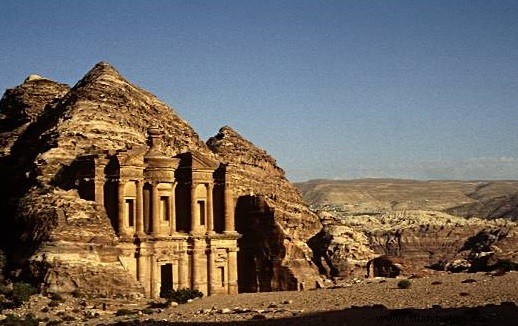 Capital of the Nabataeans until the second century AD. AD and located in present-day Jordan, Petra is an ancient city of rare beauty with the appearance of an impregnable fortress. The city, whose name means "rock" in Greek, rose in the middle of sandstone cliffs veined with red, purple and yellow where the facades of many tombs and temples were carved. Important caravan center and rich commercial city, it was supplanted by Palmyra and began a rapid decline. Taken by the Crusaders in the 12th century, it gradually fell into ruin. Petra was rediscovered in 1812 by the Swiss explorer Johann Burckhardt and today arouses the enthusiasm of archaeologists and the wonder of tourists.
Capital of the Nabataeans until the second century AD. AD and located in present-day Jordan, Petra is an ancient city of rare beauty with the appearance of an impregnable fortress. The city, whose name means "rock" in Greek, rose in the middle of sandstone cliffs veined with red, purple and yellow where the facades of many tombs and temples were carved. Important caravan center and rich commercial city, it was supplanted by Palmyra and began a rapid decline. Taken by the Crusaders in the 12th century, it gradually fell into ruin. Petra was rediscovered in 1812 by the Swiss explorer Johann Burckhardt and today arouses the enthusiasm of archaeologists and the wonder of tourists.
Petra, capital of the Nabateans
As one historian points out, of all the talented peoples of the ancient world - from the Babylonians and Assyrians to the ancient Greeks - "the Nabataeans are the most unjustly forgotten ". If they are remembered today, it is mainly thanks to Petra, their majestic city-fortress carved in the dark pink sandstone of the mountains which surround it, in the Rift Valley. This epicenter of Nabataean life, in present-day Jordan, was however forgotten for almost a thousand years - its disappearance only adding to the oblivion into which this civilization fell, the origin of which remains as hazy as a mirage in the desert.
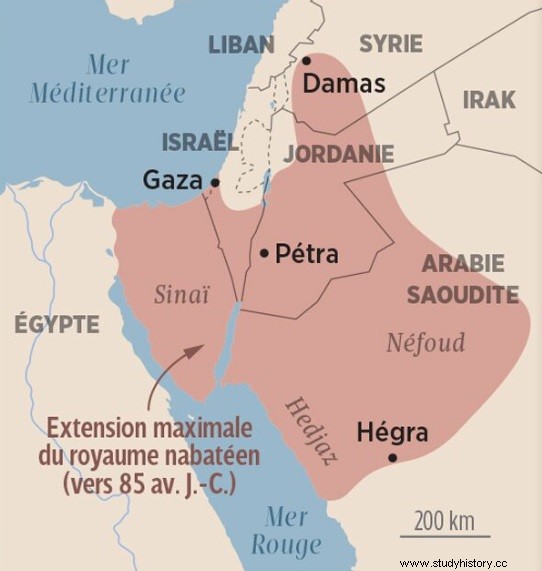 Initially completely nomadic, the Nabataeans seem to have resisted the charms of sedentary life and agriculture long after their neighbors had begun to change their way of life; they are believed to have been an Arab people originating either from Yemen, eastern Bahrain or northwestern present-day Saudi Arabia. Between the 6th and 4th centuries BC. AD, they probably migrated west to occupy, even if only on an itinerant basis, northwestern Arabia - a territory between Syria and Egypt that the Old Testament describes as the land of the Edomites. Apparently, the Nabataeans spent the next century there, pursuing their difficult lives, leading herds of sheep and camels through this semi-arid landscape, surviving by eating meat, wild herbs and milk drizzled with honey, and delivering from time to time, as a last resort, to robbery.
Initially completely nomadic, the Nabataeans seem to have resisted the charms of sedentary life and agriculture long after their neighbors had begun to change their way of life; they are believed to have been an Arab people originating either from Yemen, eastern Bahrain or northwestern present-day Saudi Arabia. Between the 6th and 4th centuries BC. AD, they probably migrated west to occupy, even if only on an itinerant basis, northwestern Arabia - a territory between Syria and Egypt that the Old Testament describes as the land of the Edomites. Apparently, the Nabataeans spent the next century there, pursuing their difficult lives, leading herds of sheep and camels through this semi-arid landscape, surviving by eating meat, wild herbs and milk drizzled with honey, and delivering from time to time, as a last resort, to robbery.
Gradually, however, their wanderings took a more commercial turn. Populating a strategic location, at the crossroads of the main caravan routes and not far from the fresh water sources of the river (wadi) Musa, the Nabataeans began to become increasingly involved in the then booming trade in aromatics ( such as frankincense and myrrh) between North Africa, South Arabia and the Mediterranean world. They were also in charge of transporting bitumen from the Dead Sea to Egypt across the Sinai desert. In a short time, thanks to their great adaptability, the Nabataeans became skillful and successful merchants, and they quickly took control of all the major trade routes in the region.
They also proved to be ingenious architects, shrewd farmers, and skilled craftsmen, crafting some of the finest pottery of antiquity. By the 2nd century BC, the area of influence of their kingdom stretched from Syria in the north to Arabia in the south, and from the Negev in the west to Al- Jawf to the east. Petra, their capital, was an urban oasis that thrived on vast supplies of fresh water. Nestled in the hollow of rocky mountains and surrounded by a semi-arid desert, it was then one of the largest trading centers in the Middle East, and even welcomed Greek diplomats at the end of the Hellenistic period.
The Golden Age of Petra
Generally, however, Petra's golden age is between the 1st century BC. and the year 106, when, on the death of the last Nabataean king, Rabbel II, their territories were finally integrated into the Roman Empire, in a visibly peaceful way. Thereafter, the city remained relatively prosperous during the Byzantine era.
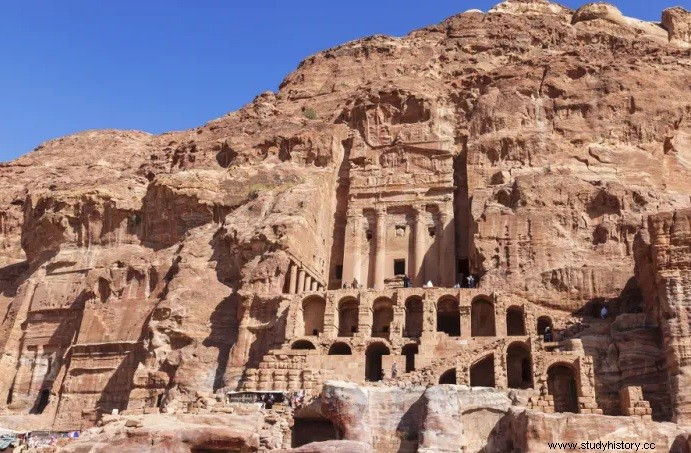 To approach Petra (a toponym that simply means "rock"), you have to follow a winding track through a long natural crack cut in the mountain, known as Siq. The city conceals its wonders behind what was once arguably an almost impenetrable defensive barrier of rose-red cliffs. Once inside the site, the visitor is immediately confronted with the magnificent finely carved stone facade of the al-Khazneh ("the Treasury"). This grandiose building, probably a royal tomb, was carved into the rock during the long reign of Aretas (9 BC-40 AD).
To approach Petra (a toponym that simply means "rock"), you have to follow a winding track through a long natural crack cut in the mountain, known as Siq. The city conceals its wonders behind what was once arguably an almost impenetrable defensive barrier of rose-red cliffs. Once inside the site, the visitor is immediately confronted with the magnificent finely carved stone facade of the al-Khazneh ("the Treasury"). This grandiose building, probably a royal tomb, was carved into the rock during the long reign of Aretas (9 BC-40 AD).
It was at the same time that the city also acquired its processional paths, temples, palaces and private dwellings. A unique and fascinating blend of Eastern decorative and architectural styles, replete with details characteristic of Ptolemaic Egypt, Petra was largely built on the classical Greco-Roman model, with a central inhabited area, or polis; a high place, or acropolis; and a necropolis, namely a peripheral ring composed of tombs and memorial rooms.
The conquest of the Byzantine states of Syria, Palestine and Lebanon by Islamic forces in 636 AD. J.-C., as well as the later establishment of Baghdad as the new capital of the Muslim world seem to have put an end to the prestige of Petra. Archaeological work has revealed that some structures were damaged:perhaps they were victims of an earthquake, or some other environmental catastrophe. Almost emptied of its inhabitants when the Christian crusaders erected a fort on top of al-Habi, a nearby mountain, it was later abandoned, given over to dust and erosion. For almost a millennium, only the Bedouin tribes passing by could observe it in silence.
The rediscovery of Petra by Burckhardt
We owe the rediscovery of Petra, at the beginning of the 19th century, to Jean Louis Burckhardt. The son of a Swiss colonel in the French army, Burckhardt spent most of his short life, as one biographer put it, “exploring the Near East convincingly disguised as a Muslim.” Although he never officially converted to Islam, he was nevertheless buried in the Muslim cemetery in Cairo under the name of Ibrahim ibn Abdallah - the one he had chosen for his travels in the region.
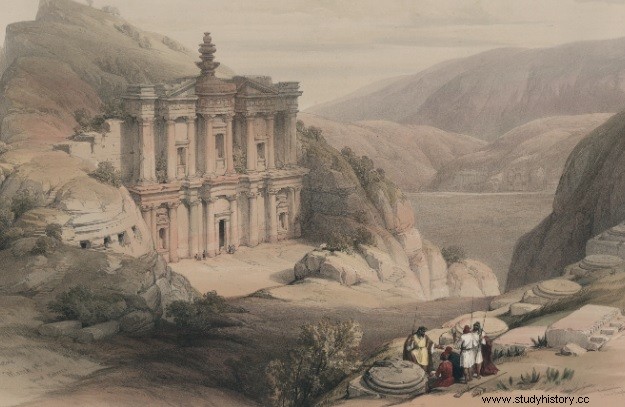 Travelling under the auspices of the Joseph Banks Association for Promoting the Discovery of the Interior of the Africa, Burckhardt, as a passionate and enthusiastic young man, did not hesitate to sometimes put himself in danger. After learning Arabic and reading the Koran, he first traveled to Syria, where he joined a caravan of camels on their way to Aleppo, before embarking on new, often extremely perilous wanderings in the inland, until reaching the ancient ruined city of Palmyra, Damascus further south, and finally Tripoli, Lebanon and the Holy Land.
Travelling under the auspices of the Joseph Banks Association for Promoting the Discovery of the Interior of the Africa, Burckhardt, as a passionate and enthusiastic young man, did not hesitate to sometimes put himself in danger. After learning Arabic and reading the Koran, he first traveled to Syria, where he joined a caravan of camels on their way to Aleppo, before embarking on new, often extremely perilous wanderings in the inland, until reaching the ancient ruined city of Palmyra, Damascus further south, and finally Tripoli, Lebanon and the Holy Land.
It was while crossing the rolling hills of Moab, Jordan, that he first heard of a mythical city buried in the heart of the nearby mountains. According to him, it must undoubtedly be the legendary forgotten city of Petra. On the pretext of making a sacrifice to the prophet Aaron, whose tomb is nearby, he not only manages to reach the city in 1812, under the watchful and worried gaze of his local guides, but also manages to sketch a plan of his layout and its location.
After another five years of frantic travels in Abyssinia (Ethiopia), Sudan, Jeddah and Egypt, Burckhardt contracted dysentery and died on October 17, 1817, at the age 33 years old. The diaries he kept throughout his travels - usually in the greatest secrecy, so as not to undermine his cover - are published posthumously and confirm the rediscovery of Petra. But even before they appeared, his plan had already started circulating among other troops of Western adventurers in the Middle East.
The enthusiasm of Europeans
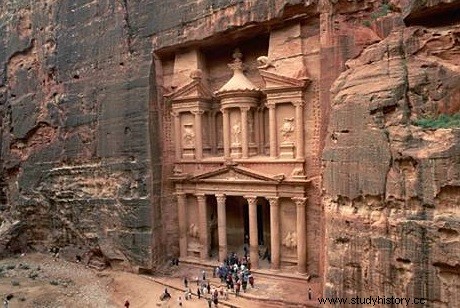 The second Europeans to reach the city, in 1818, were experienced and learned British antiquities seekers . Far from traveling incognito, Messrs. William John Bankes, Thomas Legh, C.L. Irby, J. Mangles and company arrived at Petra following Burckhardt's directions, armed with horses, servants, guns, provisions and gold coins, protected by a troop of Bedouin horsemen and blessed with the blessing of the local sheikhs. The two days they spent in the ruins enabled them to write an account of their discoveries, and Bankes executed many drawings which remain a precious testimony to the state of Petra after centuries of neglect. These images, however, remain unpublished until 1981, gathering dust in a drawer of the family home in Bankes, Dorset.
The second Europeans to reach the city, in 1818, were experienced and learned British antiquities seekers . Far from traveling incognito, Messrs. William John Bankes, Thomas Legh, C.L. Irby, J. Mangles and company arrived at Petra following Burckhardt's directions, armed with horses, servants, guns, provisions and gold coins, protected by a troop of Bedouin horsemen and blessed with the blessing of the local sheikhs. The two days they spent in the ruins enabled them to write an account of their discoveries, and Bankes executed many drawings which remain a precious testimony to the state of Petra after centuries of neglect. These images, however, remain unpublished until 1981, gathering dust in a drawer of the family home in Bankes, Dorset.
The craze for Petra only really began when the French archaeologist and explorer Léon de Laborde published an account of his 1828 expedition, led with Louis Linant de Bellefonds, the future designer of the Suez Canal. Voyage of Arabia Petraea appeared for the first time in France in 1830, in a sumptuous folio edition containing around twenty illustrated plates which were a revelation for the general public. Quickly translated into English and published in 1836 in a much cheaper and less image-rich edition, this book established Petra as a romantic and spiritual place of pilgrimage for British and Victorian American tourists wishing to visit the Holy Land.
In the following century, archaeologists excavated the site scientifically and in detail, revealing the presence of 619 rock-cut tombs and even more antechambers, as well as rooms housing and spaces dedicated to cultural activities. However, Petra has not revealed all its secrets. Although it has suffered for decades from the region's political and religious tensions, the "ruddy city half as old as time", in the words of the poet John William Burgon, is still as fascinating as ever.
To go further
- Petra and the Nabataeans, by Marie-Jeanne Roche. The beautiful letters, 2009.
- Petra:Splendors of Nabataean civilization. White Star, 2021.
- Atlas of Lost Places - Discovering the Remains of the World, by Travis Elborough. La Martiniere, 2019.
